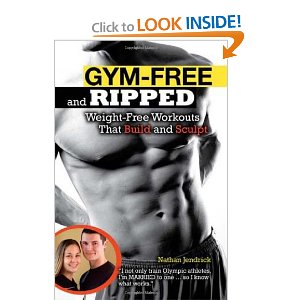Gym-Free and Ripped
By: Nathan Jendrick
Reviewed By: Michael Bedard, Personal Trainer, MBA
When you look at the picture on the cover of the book you may say to yourself this doesn’t look like a book for a 50+ male looking to get back into exercising and improving their fitness level. The picture is too intimidating. But looks can be deceiving. The picture is their for marketing purposes only, the contents inside are very practical and useful for the 50+ male who wants to start exercising without investing a lot of money in fancy equipment or expensive gyms. Read more…
Exercising regularly is hard enough. If you are over 50 it is even harder. Your lifestyle habits are well engrained and for most adults over 50 exercise is not even on their radar screen. That is until they receive a health scare. They go for a routine physical and learn that their cholesterol is higher than it should be or that their border line high blood pressure is no longer border line but high enough to warrant medication. Their doctor tells them that they have to lose 25 lbs or they may develop diabetes or risk suffering a heart attack.
Read more…
A lack of muscle strength, increase stiffness of the joints and muscles, decrease agility, balance and coordination, increased emotional stress or a decreased ability to cope effectively with occupational and life stress are all associated with the 50+ adult. Yoga is ideally suited as a one stop fix it shop for many of these aliments. Read more…
agility, balance and coordination, increased emotional stress or a decreased ability to cope effectively with occupational and life stress are all associated with the 50+ adult. Yoga is ideally suited as a one stop fix it shop for many of these aliments. Read more…
Introduction
Cardiovascular training is a key component of a balance exercise routine. For the older adult the benefits are many;
- Lowering of the resting heart rate.
- Decrease the risk of cardiovascular disease.
- Keep resting blood pressure normal
- Improve heart efficiency during physical exertion.
- Weight control
- Help maintain agility, balance and coordination to reduce the risk of falls.
- Increase your energy and stamina
- Stress management
Read more…
There are three dimensions of human frailty- time, disease and disuse. The passage of time is inevitable. The onset of disease is the result of internal system fatigue or external exposures that damage the body tissues. Medical technology has helped make the impact of disease significantly less. Disuse, sedentary living or lack of activity is devastating to functional capabilities and is the number one cause of human fraility. In order to improve our quality of life we must embrace physical activity.
Read more…
The fear of falling for the 50+ adult is a major concern. With the loss of muscle mass, strength, and endurance and the deterioration of neurologic control of our movements and slower reflexes that occur with age the fear of falling is warranted. Cardiovascular and muscle strength training helps significantly to reduce the risk of falling. However, specific agility, balance and coordination training can even further reduce the risk of falling. Unfortunately, this form of exercise training is often ignored with dire consequences.
Read more…
The structure and function of the cardiovascular system (arteries, veins, heart and lungs) and the ability of the components to work together is critical for healthy, functional and independent living. As we age, activities that seemed relatively easy to perform just a few years earlier become more difficult as our ability to produce the needed energy to perform work declines.
The wall of the chamber of the heart that pumps blood to the rest of the body increases in thickness by about 30% beginning at around age 25. This wall thickness may be in response to an age related increase in blood pressure. The aorta and arterial tree (the arteries that deliver blood to your muscles and organs) also become thicker and less compliant with age. As well, with age the heart and blood vessels become less sensitive to neurological stimulation. This means that the aging heart can’t achieve maximum heart rates that were possible during your younger years and blood pressure reflexes that accommodate for a change in pressure as we change positions from sitting to standing do not respond well and this often results in dizziness, confusion, weakness or fainting as the older adult stands up.
Read more…
One of the most overlooked components of fitness is flexibility. However, joint and muscle stiffness is one of the most common complaints of 50+ adults. A lack of flexibility compromises your ability to perform activities of daily living such as bending over, reaching, and getting out of chairs or cars. As well it compromises your ability to perform recreational sport activities such as golf, curling, biking, bowling, skating and hobbies such as gardening. Most significantly, a lack of flexibility leaves you very vulnerable to muscle and joint injury in your back, shoulders and legs.
Read more…


